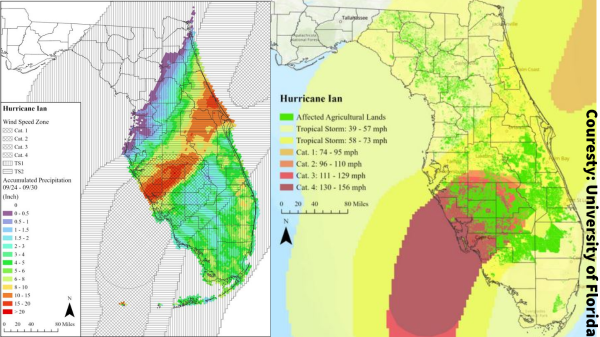The exact amount of the damage done to Florida by Hurricane Ian is starting to come into focus.
It is between $1.1 billion and $1.8 billion, according to a figure released last week by Florida agriculture officials.

This is in line with estimates issued on October 17 by the University of Florida, which reckoned total losses for all commodities (including animals and animal products) at between $787 million and $1.56 billion.
The report said that 4,773,792 acres were affected by the storm.
As is customary, the report offers various scenarios for degrees of loss.
For citrus, the low scenario was $146.9 million. The high scenario was $304.3 million.
For non-citrus fruit and tree nuts, the low estimate was $78.3 million. The high estimate was $184.5 million.
For vegetables and melons, the low scenario came to a loss of $208 million, the high scenario at $393.5 million.
Although all of Florida’s citrus acres were exposed, exposure was not always to the same degree. The Florida report breaks damage down into six categories: Tropical Storm 1 and 2 and Hurricane categories 1, 2, 3, and 4, with 4 being the most intense.
One current estimate put the current crop at 28 million boxes.
“That’s tough,” said Florida Department of Citrus director Shannon Shepp. “For some context, we did just about 41 million boxes of oranges last year. And for a little more context, back in 2004, we did about 240 million boxes.”
The hurricane’s blow hit an industry already coping with severe and chronic losses from citrus greening disease (huanglongbing).
Laine Daum, a grower of oranges and tangerines, told WUSF News, “At this point, it’s gonna be up to insurance, and hopefully the federal government, to step in and keep us in business.”
But how many citrus growers are going to take disaster payments and use them to replant citrus, and how many will turn to other crops or enterprises?



